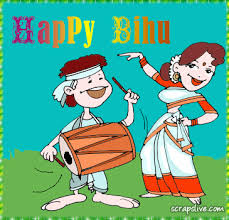 Days of Rongali BihuBihu is a festival which binds Assam, irrespective of the caste, creed and color of the people. The three types of Bihu, namely Rongali Bihu, Kongali Bihu and Bhogali Bihu, celebrates the different stages of life cycle of the paddy crop. Rongali Bihu celebrates the beginning of the Assamese New Year according to Hindu calendar and the sowing season of the rice crop. The next Bihu is Kongali Bihu which means the Bihu of the poor, as during this season the granaries of the peasants are empty. Bhogali Bihu comes during the harvest season when the paddy fields are about to be harvested. The major among these is the Rongali Bihu, which is celebrated during the mid of April and marks the beginning of spring season. We have listed below the days of Rongali Bihu and how they are celebrated.
Days of Rongali BihuBihu is a festival which binds Assam, irrespective of the caste, creed and color of the people. The three types of Bihu, namely Rongali Bihu, Kongali Bihu and Bhogali Bihu, celebrates the different stages of life cycle of the paddy crop. Rongali Bihu celebrates the beginning of the Assamese New Year according to Hindu calendar and the sowing season of the rice crop. The next Bihu is Kongali Bihu which means the Bihu of the poor, as during this season the granaries of the peasants are empty. Bhogali Bihu comes during the harvest season when the paddy fields are about to be harvested. The major among these is the Rongali Bihu, which is celebrated during the mid of April and marks the beginning of spring season. We have listed below the days of Rongali Bihu and how they are celebrated.
Rongali Bihu Days
Goru Bihu
Goru Bihu is the first day of Rongali Bihu celebration but the last day according to Hindu lunisolar calendar. Goru means cow in Assamese and the day is dedicated to the cattle itself. Early in the morning on this day the cows are washed and applied a paste made up of fresh turmeric and other preparations, and Assamese songs are chanted speaking of the livestock to become big, healthy and productive. The old ropes tied to the necks of the cattle are done away with and fresh ropes are tied. Then these cattle are set free to roam anywhere according to their will.
Manuh Bihu
The second day is for humans and it is the first day of the year according to the Hindu calendar. Everyone takes a bath early in the morning and visit their elders to seek blessings from them. The elders are gifted with bihuwan, hachoti and cheleng; according to the Assamese culture, these items are the best way to express your gratitude. Children too are pampered well on this day and are gifted with new clothes. People also visit their relatives and friends.
Husori
Husori denotes the third day of Bihu when the elders of the village, only males, form a band and move from one household to another. They sing traditional folk songs in chorus and are welcomed to the courtyard by the hosts, after which they sings songs blessing the household and also perform traditional ring dance. The elders are thanked with a dakshina of betel nut and areka nut served on a brass dish.
Fat Bihu
This is perhaps the oldest form of Bihu which have survived the test of time and is still celebrated in its traditional form by the people who live in the Lakhimpur area of Assam. The legend has that this form of Bihu was first performed in front of the Ahom king, Sukaphaa, somewhere in the thirteenth century.
Beshma
This is the Bihu which is celebrated largely by the Koch tribe. There are a number of activities in which the bhurbhura and the shak tribes participate, propose feasts and make merry.
Mukoli Bihu
Mukoli Bihu is the celebration of womanhood where youngsters of the village adorn themselves in traditional dresses and go to empty fields and perform Bihu dance and sing Bihu songs. The theme of the songs is romance and sexual love.
Jeng Bihu
Jeng means a compartmentalized place made by digging bamboo into the soil. This used to be done so that the males of the society could not see the women perform the Bihu dance, as is not supposed to be danced or witnessed by men.
Baisago
This Bihu is celebrated by the Bodo-Kachari tribe who also celebrate Bihu but in a little different manner; though their Bihu songs follow the same theme.
Bihutoli Bihu
This is the modernized form of Bihu. Bihu is more of a folk dance which is performed by the tribes of Assam to celebrate the change of seasons, especially the start of a year. But this is a public display of Bihu performance where a stage is set and Bihu is performed on it. The elevated stage that is set for the performance itself is called Bihutoli.
Haat Bihu
Haat Bihu is another name for Rongali Bihu, which literally means seven Bihus. Rongali Bihu is of different types, namely, Chot Bihu, Raati Bihu, Manuh Bihu, Kutum Bihu, Mela Bihu and Chera Bihu.